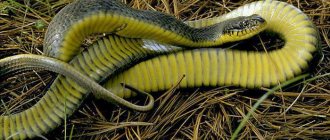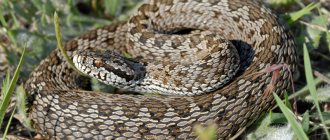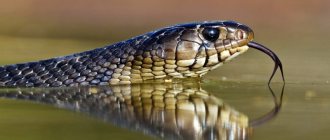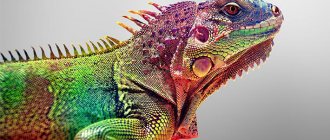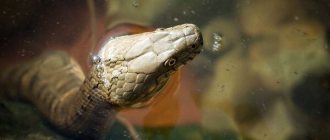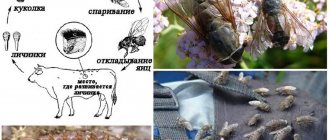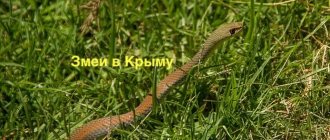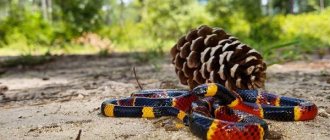Non-venomous snakes of Russia
Brownie, goblin, water - many have heard these words, but few know that this is only an abbreviated title for these mythical characters. In fact, in ancient times it was said: the Goblin Tsar, the House Tsar, the Water Tsar - these are the most famous characters. There was also the Field King, the Meadow King, and the Swamp King. They were also called Masters or Gospodars, after the corresponding prefix.
I won’t speak for all of Russia, but in White Rus' there was in ancient times, and even 200 years ago, a living personification of the Domovoi Tsar, Domovoi, or as he was popularly called Domovik. This living personification-symbol was the ordinary one (lat. Natrix natrix).
Few people are not familiar with this, in my opinion, cute snake. It can be found in the meadow, in the forest, in the country, by the road - the snake is very common. The common snake reaches a maximum length of 2.05 (usually less than 1) m. The gray-olive or brown-black back has dark spots arranged in a checkerboard pattern, a reticulate pattern and light (white, lemon or orange-yellow) neck spots. This species has full albinos and melanists.
The species is found throughout almost all of Europe (except for Ireland, Northern Great Britain, and the north of the Scandinavian Peninsula) from 67 o N. w. to North-West Africa and West Asia. To the east, the species range reaches the South-East. Siberia, North China and North-East. Mongolia. On such a vast territory, 9–12 subspecies are distinguished. In Russia, most of the country is occupied by the nominative subspecies. He also meets in the Center. and Sev. Europe. From the Volga region to the Urals, West. Siberia, Buryatia and Southeast. Siberia is inhabited by N. n. scutata (Pallas, 1771), differing from the nominative in a darker body color, more intense (up to orange-yellow) coloring of the temporal (neck) spots and a weakly expressed or completely absent pair of black spots following the yellow ones. The Persian snake (N. n. persa (Pallas, 1814) is known from most of the Balkan Peninsula, Asia Minor, Eastern Ciscaucasia, Transcaucasia and Southwestern Turkmenistan. Single finds of this subspecies were found in the Crimea.
The common snake is usually found in fairly damp places (along the banks of rivers, lakes, ponds, in coastal reeds, in floodplain meadows, in ravines, vegetable gardens and orchards, in swamps and in damp places near springs). Swims and dives well, swimming quite far to sea islands.
It can swim considerable distances underwater. It rises into the mountains to a height of up to 2300 m above sea level. ur. m. It can often be seen near human habitation: in sheds and heaps of garbage, cracks in wooden buildings, haystacks, in basements and under the porches of country houses. Such conditions are similar to natural ones, where it settles, using voids under stones, tree roots, and rodent burrows as shelters. Sometimes it is also found in gardens and vegetable gardens, forested areas of large cities.
Active during the daytime, usually hunting in the morning and evening hours. It feeds mainly on lake frogs (in some places their abundance is associated with high numbers of grass snake populations), as well as toads, tadpoles and fish fry, lizards, songbird chicks, small mammals and fish, swallowing them alive without first killing them. As a result of this, the swallowed prey remains alive in the snake’s stomach for some time. The process of swallowing prey can last several hours. Swallowing the prey begins with orienting its head into the mouth, even if at first it grabs the prey by the limb, then it gradually tries to grab it by the side, and then by the head.
It can survive without food for a long time (up to 420 days). When stressed, it regurgitates swallowed prey.
It flees from enemies or takes a defensive pose, folding its body in a zigzag, hissing and “flattening” the neck area, and rhythmically twitches the tip of its tail. When meeting a person, he always tries to slip away unnoticed. If this fails, it can defend itself, trying to scare off the enemy. Like a cobra, it raises the front part of its body, while its neck becomes flat. It hisses and lunges towards danger, sometimes even with its mouth open. However, it bites extremely rarely, even if you pick it up. The bite of its small teeth, although sensitive, is not strong or painful. Usually he tries to free himself with vigorous movements of the whole body and releases a foul-smelling liquid from the glands located near the cloaca. It also emptys the intestines by regurgitating recently eaten food and throwing out excrement. Perhaps he does this not so much as a defense, but because of stress. If this does not help, he uses a very characteristic tactic - pretending to be dead. All his muscles relax, he hangs like a rope, his mouth is lifelessly open, his tongue falls out of it, and in some cases even saliva with blood drips. He can pretend to be dead not only in his hands, but also on the ground, if the pursuer does not give him the opportunity to hide. Often at the same time, as if in convulsions, he turns his abdominal side up.
In nature, the enemies of snakes are 40 species of birds, even ants and ground beetles attack eggs of dinner, and fish (trout), amphibians (toads, frogs), hedgehogs, and small rodents attack young snakes. Cannibalism is known in the common snake. One of the snake's serious enemies is rats, which destroy its clutches and offspring near human habitation.
The active period lasts from mid-March - early April to September - November. Snakes overwinter under roots, in cracks of coastal cliffs, rodent burrows, and basements. Joint wintering with other species is rare. At least three moults occur during the active season.
Mating occurs in April - May. During this period, they form clusters of several dozen individuals (mating balls), consisting of one female and about 20 males.
Eggs measuring 12 - 20 x 20 - 30 mm are laid in July - August in rotten stumps, heaps of leaves, peat, and manure. The volume of clutches varies from 4 to 50 (rarely up to 105) eggs. One female with a body length of up to 70 cm normally lays 6 - 16 eggs, individuals with a length of 0.7 to 1.0 m - 12 - 21 eggs, and more than 1 m - usually up to 35 eggs. Sometimes so-called collective clutches occur, when several females lay up to 3000 eggs in the most favorable areas of the biotope. The eggs laid in them are covered with a sticky protein, as a result of which they stick to each other and surrounding objects. “Glued” dense masonry is better preserved due to the reduction of moisture loss in it. Young individuals reach a length of 11 - 26 cm and a weight of 7 - 8 g. Sexual maturity occurs in the third - fourth year of life.
The common one is already included in the Red Books of the Moscow and Tomsk regions. Limiting factors are: construction, reclamation and agricultural work in their habitats, death on roads, uncontrolled catch for sale, etc. In a number of other regions of Russia, it has also become rare.
This is what this living creature looks like, is common, and lives like.
As, I said at the beginning, an ordinary person was considered by the inhabitants of White Rus' to be a Domovov-Domovik. But this character could not be any forest “yellow-eared” snake, but only one that lived near a person - under his house.
This one was considered a real member of the patriarchal family, fed by the family - the hostess poured him fresh milk into a special bowl every day, and the owner gently took him in his calloused hands and caressed him, the way we are used to treating cats. Often it crawled into the owner’s arms when called, which is very unusual and rare for snakes that are difficult to train. Children were strictly forbidden to play and offend the Brownie Snake. Killing the Brownie Snake was considered a terrible sin, which without a doubt brought disaster to the house. The House Snakes lived as part of a “family” for decades.
This tradition may seem stupid, meaningless and disgusting to many, but it turns out that not everything in it is meaningless! Being interested in biology, I learned about several quite unusual and interesting facts, unfortunately little known:
Fact No. 1: In the territory where the grass snake lives (which is several hundred square meters) there are no vipers, a poisonous and dangerous snake that used to literally swarm throughout White Rus'. He doesn’t tolerate her and expels her from his territory. In addition, the viper cannot stand the smell emitted by the snake. Fact No. 2: Mice and rats cannot stand the smell, where there are very few rodents. Fact No. 3: The snake catches frogs “with live bait” - it uses its own tongue as bait, and as a result, the frog itself jumps into its mouth, wanting to feast on a worm, which it mistakes for the snake’s tongue - I’ve seen this myself a couple of times.
It is for the first two advantages, I think, that my ancestors valued the snake.
The ancient inhabitants of White Rus' also considered snakes living outside the home to be sacred snakes, the Tsar Snakes, because of their yellow “ears.” Many legends about the Tsar have already arisen due to cases when the yellow “ears” of a snake really resembled a crown during the snake’s molting, when the skin bulged out, and when meeting people, the latter mistook the exfoliated part of the skin for the Tsar’s crown. This is how common it is. , but not an ordinary snake!
Unfortunately, many people kill snakes for various reasons: someone is afraid of snakes in general, and therefore kills them all; - someone does not distinguish a snake from a poisonous snake (there are snakes without yellow “ears”). As a result, a useful and harmless snake becomes a victim of a thoughtless person.
And, it is quite possible that by killing a snake in the courtyard of their house or dacha, they actually open the door to their enemies - mice and rats, and such a dangerous neighbor as a poisonous snake - a viper!
Skids
patterned runner
Snakes are large non-venomous snakes more than two meters long . Distributed both in the Caucasus and Central Asia, as well as in the south of the Far East, and even in North America.
olive snake
Snakes are very fast snakes. Only the mamba crawls faster than them. It should be noted that the snake crawls at the same speed (about 6 km/h) both on stone or sandy mail and on tree branches. Sometimes it’s hard to call it crawling, because when moving along the branches, most of the snake’s body is in the air.
The snake also swims no worse than it crawls.
yellow-bellied snake
The snake usually poses no danger to humans. Although the aggression of some species, for example, the spotted or yellow-bellied snake, requires caution. They can attack for almost no reason, jumping high and trying to bite the face.
leopard (big-eyed) snake
The big-eyed snake can also rush at a person, but only in a hopeless situation. Despite its height, or rather its length of 3.5 meters (of the non-venomous snakes, only boas and pythons are larger), it perfectly climbs the thinnest branches in the crown of a tree, hunting birds. In search of food, a big-eyed snake can crawl into a barn or even into a house. There he hunts rats and mice, and along the way, chickens.
The snake's bite is quite painful, but absolutely not dangerous. Although this statement does not apply to all runners. After a bite from a patterned snake, all the signs of poisoning by snake venom appear - swelling, dizziness, severe pain. Some equate the bite of a snake with the bite of a steppe viper. All symptoms disappear in about three days.
In any case, you need to be careful when handling runners . But this does not mean that they need to be destroyed.
Common copperhead
The common copperhead is a relatively small (up to 70 cm long), massive and strong snake. Not dangerous for humans . The tail makes up a fourth or fifth of the total length. She has a flattened head and weakly demarcated from the neck. The scales are smooth.
The upperparts are grayish or brown, sometimes with a red tint. Reddish coloring is more common in males, brown - in females. Against this background, there are two to four longitudinal rows of dark spots on the back, sometimes unnoticeable. There is often an arched dark stripe on the head. A dark stripe runs from the nostril through the eye to the corner of the mouth, and the eyes themselves are often red. Small specks are scattered on the sides of the body. The underside of the body, like the upper, is gray, brown, pink or reddish in color. The pattern of the ventral side consists of dark blurry spots and specks, sometimes a dark gray stripe runs down the middle of the abdomen. The underside of the tail is lighter colored. Newborn copperheads are brighter in color: the dark pattern on their back is distinct, and the underside of the body is red. Thanks to the reddish tint of the back and copper-red belly, this snake got its name.
Due to its massive build and similarity in color, the copperhead is often confused with the common viper. The most noticeable differences between these cohabiting species are as follows. The viper has a spear-shaped head and is clearly demarcated from the neck. in the copperhead it is narrower and the neck interception is faintly noticeable. The head of the copperhead is covered with large scutes, while that of the viper is covered with small ones. The body scales of the viper are ribbed, while those of the copperhead are smooth. The pupil of the copperhead is round, while that of the viper is vertical.
Range of the common copperhead
The range of the copperhead includes almost all of Europe, Western Kazakhstan, Asia Minor, the Caucasus, and Northern Iran. In Russia, the species inhabits the European part, reaching Lake Onega in the north and Western Siberia in the east.
The common copperhead is an inhabitant of wooded areas. It is found in deciduous, coniferous and mixed forests, adhering to sun-warmed edges, clearings, and overgrown glades. In open areas - steppe areas and meadows - it is observed less frequently. In the mountains, it is common on bush-covered slopes, sometimes found in meadow and subalpine zones, rising to a height of 3000 meters. The population density of the copperhead is quite low everywhere; this snake is much less common than the vipers and grass snakes that live together with it. In many parts of its range, especially in the north, it is known only from isolated finds.
Japanese already
The Japanese snake is approximately fifty centimeters long. Body color is dark, closer to brown. Mouth in the form of a yellow stripe.
Note!
Domestic turtles - the most popular species, cultivation features, tips for care and maintenance (115 photos + video)- Indian snakes: sacred, poisonous, most common and dangerous types of Indian snakes and their names (130 photos)
Sea snakes - appearance, description of habitats, distribution and overview of the most poisonous representatives (145 photos + video)
Younger individuals are black. The habitat of the Japanese snake is forests with various trees and plants, meadows, and bushes. They are found in Japan, Primorye, Khabarovsk Territory, and Amur Region.
The Japanese snake feeds on worms, mollusks or frogs.
Copperhead lifestyle
The copperhead leads a mainly terrestrial lifestyle, although it can also crawl onto the branches of bushes. Shelters include rodent burrows, spaces under stones and tree trunks, and cracks in rocks. The copperhead avoids damp places and enters water very reluctantly, although if necessary it can swim quite well. It is thermophilic and usually active during the warm daytime. However, sometimes it crawls to the surface at dusk or on a clear moonlit night.
Copperheads are very attached to a specific place of residence: each individual lives in a relatively small individual area, where it can be found from year to year.
Copperheads have a characteristic defensive behavior. When attacked by an enemy, she curls up into a tight ball, inside which she hides her head. She reacts to attempts to touch her by shrinking even more. From this position he can make throws towards the enemy with a sharp hiss. When picked up, the copperhead bites fiercely and can bite through the skin until it bleeds. Perhaps this explains the hostility of people towards the copperhead in many places where it is distributed. Sometimes it is completely unreasonably considered the most poisonous snake, more dangerous than the viper. In addition, like snakes, copperheads can “shoot” at the offender with secretions of the cloacal glands.
Defensive behavior and resemblance to a viper do not always save the copperhead. It is obtained by various birds, martens, wild boars, hedgehogs and even rats. Newborn copperheads can also be eaten by such non-dangerous animals as grass frogs or large songbirds.
In captivity, these snakes are less likely to show their unfriendly nature and gradually become so accustomed to the terrarium that they take food from the owner’s hands.
Signs of poisonous snakes
You can sometimes tell which snake is not poisonous by the appearance of the reptile.
Here are some signs:
- Safe snakes have a more rounded head , smoothly blending into the body. Venomous reptiles often have a triangular head with a narrow neck.
- Many non-venomous snakes have a round pupil , whereas dangerous snakes have an elliptical pupil.
- When swimming, only poisonous reptiles keep their bodies on the surface of the water. Non-venomous snakes swim in the water column .
- Bright warning colors are often characteristic of venomous snakes. Non-dangerous snakes, as a rule, do not like to stand out. Although there are many species that mimic their poisonous counterparts.
What do common copperheads eat?
The common copperhead eats a wide variety of vertebrates that it can find in its distribution areas, but prefers lizards of all kinds. It is rather slow and hunts not active animals, but those resting in shelters. That is why it often preys on secretly living spindles. It often lies in wait for its prey, sitting motionless in ambush, and then quickly rushes at the unsuspecting lizard when it crawls close enough. It wraps the victim in rings around its body, but sometimes does not strangle it, but thus holds it in a position convenient for swallowing. The copperhead's muscles are more developed than those of the grass snake or viper; it is capable of holding with its rings even such a small “detail” as a lizard’s foot. It can be difficult for a small snake to cope with large, strong lizards. Sometimes real battles take place, in which the snake often wins. True, it happens that a defeated lizard, in its death throes, clings its jaws so tightly to the snake that, swallowing its prey, the copperhead tears it away from itself, like a bulldog, sometimes along with its own skin. Her poisonous saliva, which is dangerous for cold-blooded animals, also helps her cope with lizards, which enters the victim’s blood with a strong bite.
Obviously, the poison helps to deal with other victims - on occasion, they become snakes and other snakes. There are known cases of cannibalism. Copperheads have an excellent appetite. It can swallow very large prey (for example, a 35-centimeter long spindle was found in the stomach of a snake 57 centimeters long) and several animals at once (three viviparous or fast lizards were sometimes found in the copperhead’s stomach). While exploring various secluded places in search of prey, the copperhead also crawls into rodent burrows and willingly eats naked cubs there.
In spring copperheads are found in pairs. Like slender snakes, during mating the male holds the female by the neck with his jaws, wrapping himself around her body. Mating can also occur in the fall - in this case, the female brings offspring the following summer.
What to do if you are bitten
If you are bitten by a non-venomous reptile, there is no need to panic. Examine the bite site. There should not be two points on it, as from a poisonous snake bite, but only scratches, usually jagged in shape, will remain. All you need to do is wash the wound with water and disinfectant. Hydrogen peroxide, alcohol, and vodka are fine.
Then you need to immediately consult a doctor. He will definitely establish that the snake is non-poisonous and the most he will do is wash the wound again and give a tetanus injection. The venom of even a harmless snake can cause an allergic reaction. It would be a good idea to take an antihistamine.
Important! There is no need to suck the poison out of the wound, much less pick or cauterize it. This can introduce harmful bacteria into the affected area.
Where does the brittle spindle live and its way of life?
Brittle spindle is a forest dweller. It can be seen in deciduous and mixed forests, as well as on forest edges and meadows. May enter fields and gardens. In the Caucasus, it lives in mountain forests, on slopes covered with low vegetation, in forest meadows and in open steppe with bushes. It rises to a height of up to 2300 meters in the mountains. This lizard loves shaded, damp places, but can also crawl out into the sun or into a dry place, but not far from its shelter.
The spindle is active in the evening and morning twilight, spending the rest of the day under stones, in loose soil between the roots of plants, in dense weaves of grass, in rotten stumps, under dead wood, in the burrows of small mammals. In loose soil, the spindle can make its own move, pushing and “drilling” through it with its head.
Like most lizards, the spindle leads a sedentary lifestyle. Its individual areas are small - only a few meters in radius. Young individuals that are born also disperse over short distances.
Despite their snake-like appearance, spindles are slow and somewhat clumsy. When crawling, they use the most common method of movement among snakes - they bend their body and tail in waves, but their movement is impeded by a bony shell. Hard coverings protect these lizards from damage when they climb in thickets, piles of dead wood, among stones or on the forest floor, but slow down their crawling on level, open ground. The spindle, like snakes, can swim with its head above the water, but it clearly “does not like this”, quickly becomes exhausted and enters the water only when necessary.
The brittle spindle is not only a poor swimmer, but also a poor hunter due to its slowness, as well as poor eyesight. Unlike other lizards, it does not distinguish colors; moreover, it barely recognizes even shades of gray. However, given her secretive, semi-underground lifestyle, this is not important. The spindle compensates for its weak vision with developed sensitivity to odors, which it detects, like snakes, with the help of its often protruding forked tongue.
Non-venomous snakes that can be found anywhere
Common snake
To the question “What is the name of a non-venomous snake?” Most of our fellow citizens will answer briefly without hesitation - really! Perhaps this is the most famous of the non-dangerous snakes. This small snake rarely grows longer than one meter. Color ranges from gray-olive to black-brown with a specific pattern. A distinctive feature is the presence of a pair of orange-yellow neck spots or spots of lighter colors.
Already ordinary
The snake lives in swampy places, not far from water bodies. He is an excellent swimmer and can dive by holding his breath for a long time. This snake feeds on small vertebrates (frogs, tadpoles, small fish, mice, bird chicks, etc.).
How does brittle spindle feed?
The constant food of the spindles is the same slow, semi-underground lifestyle of slugs and earthworms. It is not difficult to find them in a damp place in the forest, so there is no need to crawl a lot and you do not need a large individual area. There is also no need to pursue and examine such prey. Having discovered the victim, the spindle does not rush the gay: it “sniffs” it with the help of its tongue, then begins to swallow it. At the same time, she periodically rubs her head on the ground, wiping mucus from food and from her muzzle. Eating large prey can last for half an hour or even longer. The sharp, curved back teeth of the spindle allow it to hold the slippery elastic body of the victim. They also help remove earthworms from their passages: gradually intercepting the body of the worm with its jaws, it slowly pulls it out entirely. If the worm clinging to the walls of the burrow with its bristles cannot be pulled out, the lizard unscrews the part that it has already grabbed. They repeatedly observed how two spindles, grabbing one worm from both ends, tore it in half, rotating the whole body around its axis - one clockwise, the other counterclockwise.
With the help of its back-curved teeth, the spindle even manages to pull snails out of their shells. To do this, she, resting her muzzle against the base of the shell, gradually intercepts the muscular “leg” of the snail with her jaws higher and higher. On occasion, the spindle can profit from millipedes, woodlice, and caterpillars. Since, like snakes, it can swallow large prey, occasionally other lizards, young lizards of the same species, and even snakes become its victims. The following fact is known: a spindle 29 centimeters long swallowed a young snake 18 centimeters long. There were no cases of eating vegetation.
Brahmin blind horse
The Brahmin blind beetle is easy to meet in the southern regions of the country. It lives in southern Asia, India and Sri Lanka. This is a very small snake, whose body reaches eleven centimeters in length. The scales of the blind mole have a shiny brown color.
The habitat of the Brahminy blind beetle is land that is used for planting. Therefore, this type of scaly animal received another name - “potted snake”. All the distinctive features are visible in the photo of the small snake.
Reproduction of brittle spindles
Little is known about the social and mating behavior of spindles, since all their contacts take place in shelters. During the mating season, males become aggressive and fierce fights occur between them. Their main weapons are teeth (since there are no limbs). Marriage partners find each other, apparently, by smell. They mate in the spring, with the male holding the female by the neck with his jaws.
The female bears the offspring for about three months. In mid-summer and early autumn, she gives birth to cubs in transparent egg shells. In nature, this happens somewhere in a secluded place. In a litter there are from 5 to 26 cubs, which immediately after birth begin to move, break the shells and crawl away. There have been cases of females eating newborns. Young spindles feed on small soil animals.
Not earlier than in the third year of life, having reached a length of about 25 centimeters, they become sexually mature.
Why are snakes poisonous?
Due to their structure, snakes are not known for their speed of movement. The absence of limbs also deprives these reptiles of the ability to fully catch and hold prey, as well as defend themselves from predators. Therefore, in some species, evolution has taken the path of using poison. Venom by snakes is used both as a hunting mechanism (immobilizing and killing the victim), and as a method of self-defense and protection.
However, not all snakes have acquired these formidable weapons. In nature there are poisonous and non-venomous snakes. Below we will consider only a small part of the non-venomous snakes that can be found in Russia.
This is interesting! How to use clematis grape-leaved to decorate your garden
Blue Racer
The snake with this unusual name is in danger of extinction. This partly explains her aggressive behavior towards people, so you shouldn’t even get in close contact with her. The snake has a soft blue color with white stripes. She develops high speed, for which she was nicknamed the racer.
Photo source: https://billionnews.ru/
Interesting Facts
- Snakes live almost everywhere, with the exception of Antarctica, New Zealand, Iceland, Ireland and some small islands of the Atlantic Ocean.
- Snakes evolved from lizards. Among living lizards, their closest relatives are the iguanas and fusiformes.
- The largest snakes are reticulated pythons and anacondas - their length can exceed 7 meters. The smallest snakes on the planet are Leptotyphlops carlae, whose length does not exceed 10 centimeters. McCoy's Taipan
- McCoy's taipan is considered the most poisonous snake in the world - the poison obtained from one individual is enough to kill 100 people. Its venom is approximately 180 times stronger than that of a cobra.
- The eyelids of snakes are transparent and remain constantly closed.
- Snakes can hibernate under unfavorable conditions.
- As of 2022, 3,631 species of snakes are known to science.
Video
Horned viper
Despite the horns and aggressive appearance, this snake is very friendly. She will not attack a person first and will bite solely for the purpose of self-defense. Its scales rise up to look like sharp spines. The viper lives in the deserts of North Africa, and during the day it sleeps, burying itself in the sand. Therefore, when walking along the African sands, look carefully at your feet.
Photo source: https://www.zoopicture.ru/
snake poison
Snake venom has a complex composition. It contains enzymes
, changing or destroying many body substances, toxins, proteins with a specific effect. Different species of snakes use different potent substances.
The venom of aspid and sea snakes contains neurotoxins and acetylcholinesterase, which destroys acetylcholine. In the body of a bitten animal, the transmission of signals from nerves to muscles is disrupted, and muscle paralysis develops. Most often, the animal dies from respiratory arrest.
The venom of viper and pit snakes causes an increase in the permeability of blood vessels, disturbances in the blood coagulation system and a drop in blood pressure. As a result, hemorrhagic swelling of tissues develops and their blood supply deteriorates.
There are many serums used to treat envenomation, some can be used against the venoms of several species of snakes.
The activity of snake venom is assessed in MED - mouse action units: when studying various toxins, they are injected into laboratory mice and the amount of poison that can kill 50% of experimental animals is determined. 1 HONEY corresponds to the activity of 0.11 mg of viper venom or 0.0776 mg of viper venom.
About 500 species of snakes are dangerous to humans. It is believed that up to half a million people are bitten by snakes every year, of which up to 50 thousand die. Of course, this is not the most common cause of death in the modern world. Snakes do not attack without reason and try to save their poison. The work of scientists to create serums has significantly reduced the number of deaths from snake bites. For example, in Thailand at the beginning of the 20th century. up to 10 thousand people died per year, today – 20 people
To obtain the serum, horses are injected with small amounts of poison. Over the course of several months, they develop immunity to the poison and antidote substances appear in the blood, which become the basis of the serum. Antidotes adsorb the poison, can oxidize it or form insoluble salts with it, and also, competing with the poison, displace it from compounds.
To obtain snake venom, snakes are kept in special rooms - serpentariums, the first of which was created at the end of the 19th century. in Sao Paulo (Brazil) at the Institute of Snake Research. Now in Russia there is a large serpentarium in Novosibirsk (there were more than ten of them in the USSR).
Snake venom in small doses is used for medicinal purposes; it has an anti-inflammatory effect, has an analgesic effect, and also stimulates tissue regeneration.
King Cobra
The king cobra is not only beautiful, but also extremely dangerous. Its venom is the most deadly compared to the venom of all representatives of this species, and its length is about 3–4 meters.
Its color ranges from dark brown to yellow-green, and the hallmark of such a snake is its exquisite hood.
Photo source: https://pets2.me/
White Texas Snake
This snake is called a rat snake because it resembles the color of a white rat. Its snowy color has an admixture of soft pink, similar to the circulatory system of this animal. And her head is flattened and resembles a mouse muzzle. However, the snake is not so harmless in appearance. The snake is non-venomous, but its bites are painful and can cause allergies. But despite this, breeders love him very much.
Photo source: https://fotovmire.ru/
